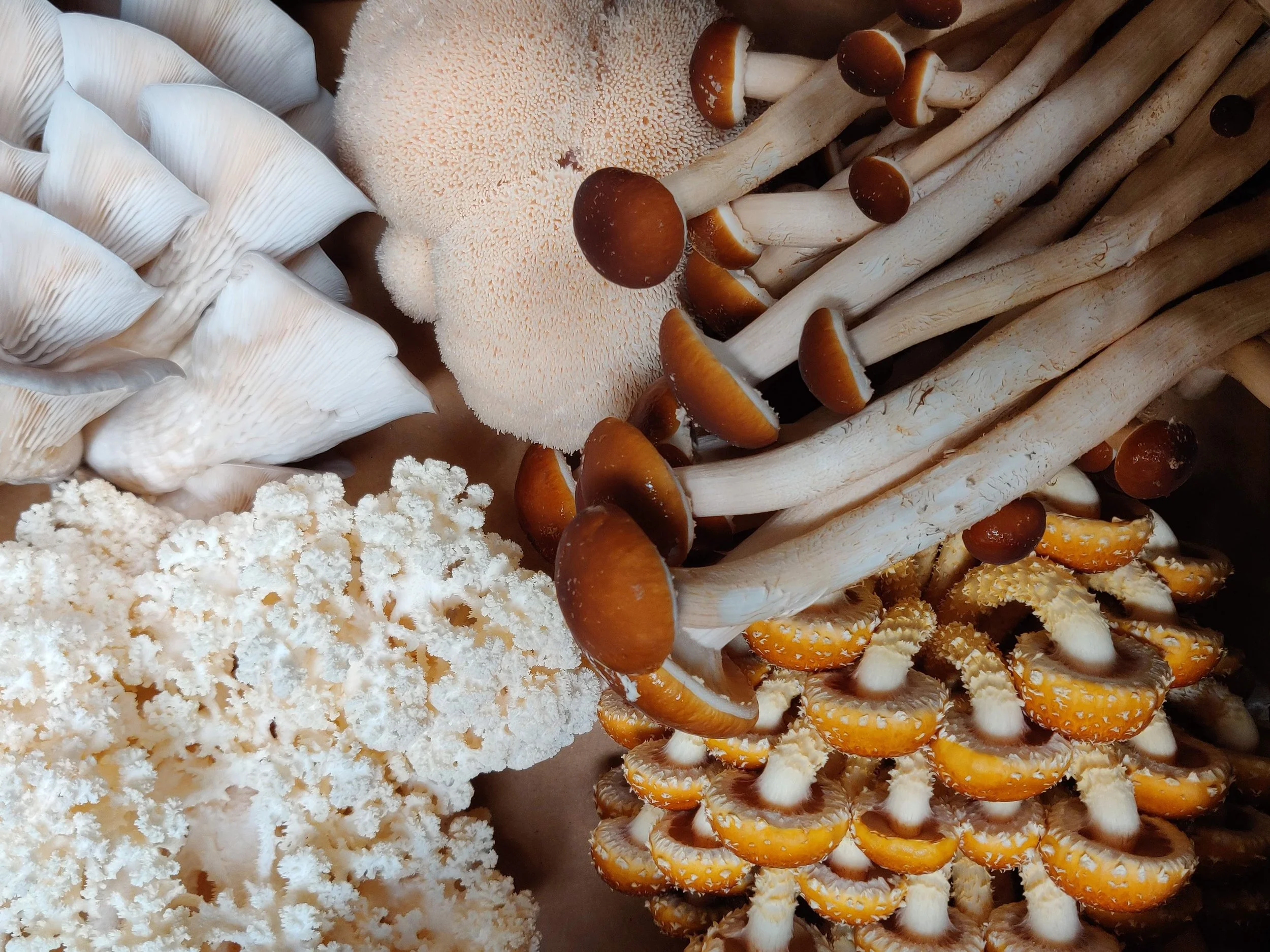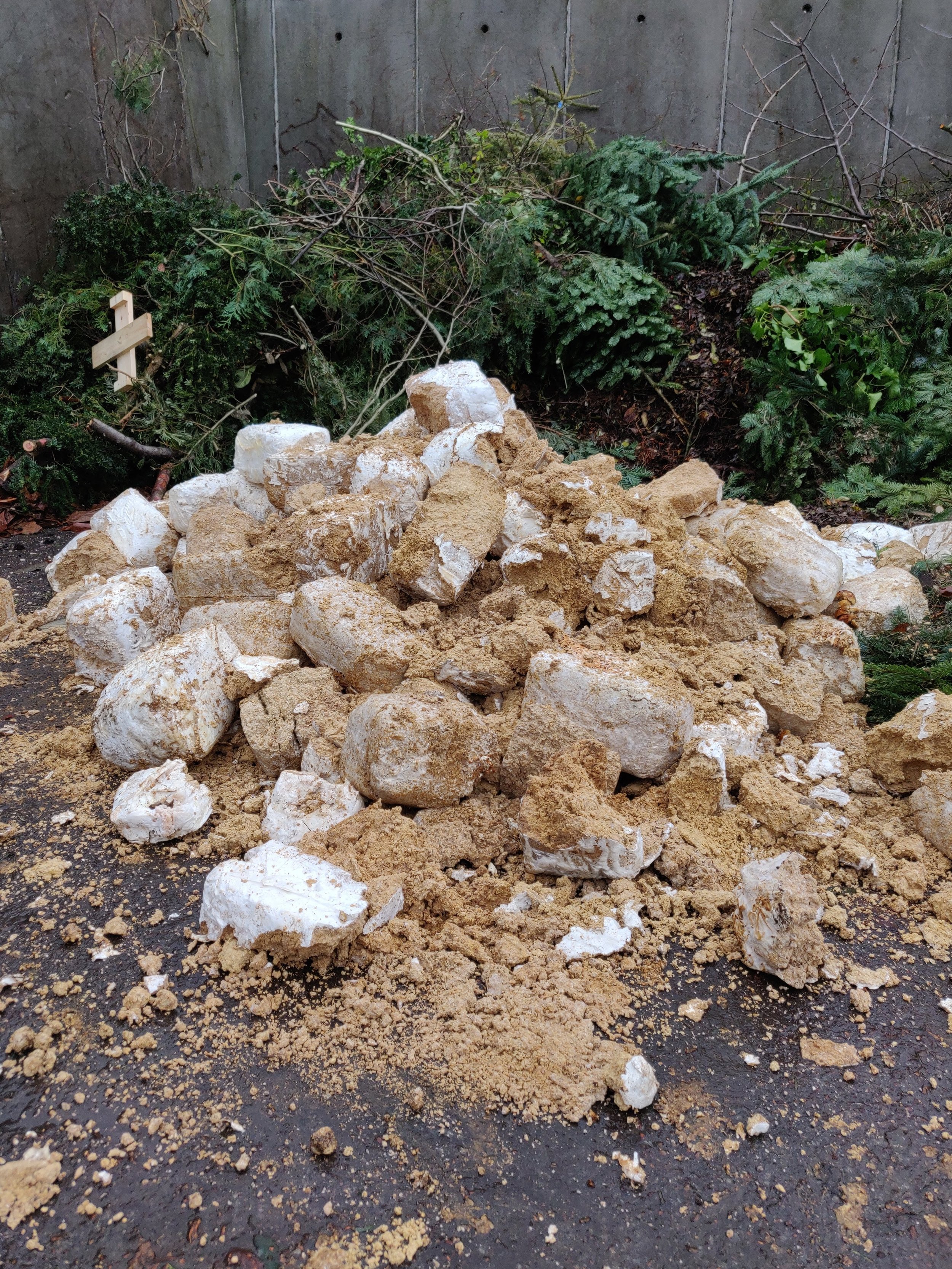
Sustainability.
Sustainability sells and the result is rampant greenwashing everywhere you look! It is muddy water and navigating is difficult to do at a glance, especially when the labels we often rely on to guide the way say very little about the true nature of things.
We don’t have an answer for this dilemma but we have a strategy. Transparency. What follows is the story of what we do and how we do it so you can better understand where your food comes from and why that matters.
Energy
Mushrooms are masters at recycling! The ones we grow specialize in decomposing one of the toughest natural materials, wood. Essentially, all the energy they need to survive comes from the materials they consume. Since mushrooms do not photosynthesize, ordinary office lights suffice. In turn, most energy consumption is in the form of cooling in the summer and heating in the winter to emulate that constant cool environment synonymous with the autumn season. The lessons we learned growing out of a small basement in Nordvest, taught us how to work with the seasons. We grow warm weather mushrooms like Yellow Oysters and Pioppinos in the summer where 18-20*c is easier to maintain than in the cold of winter. We are taking these lessons to our new operation in a mission to optimize the efficiency of our system and the energy required to sustain it.
Regarding water water consumption, the sawdust blocks we grow our mushrooms on are approximately 60% water. Our blocks have about 2 liters of water and produce 1kg of mushrooms. Including water used for cleaning or humidification, even if adding these factors doubles the water usage (it doesn’t), we are talking about fractions of the total water used in most other food production, not to mention what is used in the meat industry.
To sum it up, mushrooms are an extremely sustainable organism to work with both in regards to the energy required to operate and water consumed.
Inputs
All of our organic inputs are sourced locally and within Denmark. Because the mushrooms we grow are natural wood eaters, the base of this substrate is wood. The sawdust we use is a popular industrial bi-product that is often used in animal bedding or for burning in a wood stove, we believe it can serve a higher purpose.
Certain nutrient inputs can stimulate growth, therefore, we add nutrient rich agricultural byproducts as a supplement.
We are currently building Funga Farm 2.0 alongside our friends who brew beer at Brøl and are working closely with them to incorporate a more circular model for the supplements we use. Stay tuned!
Method
Mushroom farming can be broken down into three main areas of production:
1. Spawn production and genetics
2. Substrate production and incubation
3. Fruiting and sales.
While there are strategic and economic reasons to focus on only one or two of these functions, we do all of the above. There is more labor and more risk involved but the more technical aspects of the production are the most exciting! What's more, keeping every aspect of production in house is by far the most sustainable model.
Because we do produce our own spawn (mushroom seed) and maintain our own genetic library, we are able to grow unique and novel species of mushrooms, many of which originate from local Danish forests. Part of our mission is to grow more endemic species so our production gives back to biodiversity in our local ecosystems rather than promoting industrial monocultures. Chefs and consumers also get a better product when we are not stuck growing the same old (and often patented!) varieties. Breaking this mold is what excites us the most about our project!
We knew from the beginning that mushrooms have the potential to be the new “meat” but habits and tastes have to shift on a much larger scale for this to come true. To make this shift, people need to experience the full potential of what mushrooms can offer the palate and understand that they are so much more than the champignon they grew up with. What's more, a bad mushroom experience could turn off even the most adventurous consumer, which is why quality is of the utmost importance to us and to our overall goal of creating a more sustainable model less dependent on meat.
Waste
Our main waste product is spent mushroom substrate (sms). It is an organic material that is the perfect garden mulch and works great as a soil cover for bushes and trees where it will provide frost protection while breaking down and releasing nutrients to the soil slowly. It is halfway to becoming a rich dark compost perfect for any sustainable market garden. It can be fed to bugs or worms for worm castings. It can be fed to cows and chickens as a healthy dietary supplement. The uses are never ending. We have some plans for the future but being a small urban farm has limited our ability to experiment with these things for the time being. We are currently looking for people to collaborate with whether you are a market garden, have an apple orchard, or want to set up a worm bin operation, we would love to work with you to find a way in which we can continue to get value out of this amazing bi-product. Please reach out to hello@fungafarm.com, if you or anyone you know might be interested in working with our spent mushroom substrates.
Non-Renewables
The elephant in the room when it comes to mushroom farming is the plastic used to contain our artificial logs as they are colonized and consumed by the mushroom mycelium we grow. While plastic has tarnished our legacy and pollutes our oceans, it has also advanced technology in ways no other material has. Just imagine surgery without rubber gloves and PPE! While we are strongly opposed to the over use of plastic in so many aspects of our lives, we are grateful for the advances it has allowed, especially regarding its use in mushroom farming. What other vessel can withstand high temperatures, allow for gas exchange so our mushrooms can breathe, and seal shut to keep out mold and bacteria contamination while our mushrooms grow? None. We envision a future where plastic is used, not flippantly, but instead only where it plays an essential role that no other material can easily fill. We believe mushroom farming is one of these areas, but the fact remains, we must always look for ways to reduce our footprint. One of our bag manufacturers is working to develop biodegradable plastics that can withstand the same high temperatures required, but we are still some time out from it being a scalable model. Until that time we will continue to remain involved in the conversation and our doors are always open.





